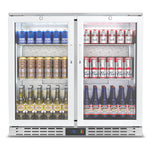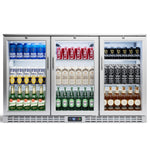You have no items in your shopping cart.
At the heart of restaurants, hotels, and grocery stores lies a critical piece of equipment: the commercial ice machine. Delivering clean, quality ice directly impacts customer health, brand reputation, and equipment longevity. Neglecting its cleaning and maintenance not only risks ice contamination, leading to foodborne illnesses, but also reduces cooling efficiency, drives up energy costs, and increases repair expenses. It breaks down the core logic and practical steps of commercial ice machine cleaning, blending industry standards with hands-on experience to help operators build a standardized cleaning system. Even if you’re new to ice machine maintenance, here’s your roadmap to long-term, reliable equipment performance.
When it comes to how often to clean, start with the manufacturer’s guidelines, usually a deep clean every 3-6 months. Pair this core schedule with daily habits: wipe the exterior, check the interior, and never let dirt linger. Add weekly tasks, too empty the ice bin to stop stagnation. But adjust timelines for special cases: For high-use spots like busy bars, shorten deep cleans to every 2-3 months. In hard water areas or places with dirty tap water, add monthly descaling treatments and install a water filter, which cuts mineral buildup at the source. And if you spot warning signs: strange noises, slower cooling? Stop using the machine right away. Conduct a full clean and inspection; address issues early, and you’ll avoid bigger headaches later.
Before you start cleaning, prep properly. Gather machine, specific cleaner, food-grade sanitizer, soft microfiber cloths, a soft-bristle brush, safety gear, gloves, and goggles are a must. Next, turn off the machine’s power and water supply, then unplug it; electric shock is a risk you can’t ignore. Empty the ice bin; leftover ice will absorb cleaner, making it unsafe.
The cleaning process changes a bit depending on whether your machine has an auto-clean function.
For machines without it, start by disassembling removable parts and follow the manufacturer’s manual closely. Place parts on a clean surface; never set them on the floor. Apply diluted cleaner to the machine’s interior, then use the soft brush to gently scrub tough scale or tight gaps. Soak removable parts in diluted cleaner for 15-20 minutes. After that, rinse the interior and parts with warm running water; do this at least three times. Leftover cleaner ruins ice taste, so don’t rush this step. Dry everything thoroughly; moisture leads to mold. Next, sanitize with a 50-200ppm chlorine solution. Let it sit 10-15 minutes to kill remaining microbes, then rinse and dry again. Reassemble the machine, reconnect power and water, and run one full ice cycle. Discard the first batch of ice, which ensures no cleaner or sanitizer is left. Finish by wiping the exterior with a damp cloth and mild detergent.
For machines with auto-clean, it’s simpler: Empty the bin, add the recommended amount of cleaner to the designated port, and start the auto-clean cycle. After the cycle, discard the first ice batch and wipe the exterior. Equipped easy access self-cleaning design ensures that a majority of services, cleaning, and maintenance can be our Coolake's commercial ice maker done easily. The units keep operation simple and feature an audible alarm and easy-to-use diagnostic features should a problem arise.

To keep cleaning safe and effective, stick to these rules: Always use cleaners the manufacturer recommends. Harsh acids or alkalis corrode stainless steel and plastic parts. Never use sharp tools like steel wool or scrapers; they scratch surfaces, and scratches become hiding spots for bacteria. Too weak, and it won’t kill microbes; too strong, and it leaves toxic residue. Keep track of cleaning supplies with an inventory log or visual tool, and restock early, so you never delay cleaning. On the management side, assign clear roles. Have cleaners log dates, methods, machine conditions, and any issues they find.
At its core, cleaning a commercial ice machine isn’t a one-time job, but an ongoing commitment to safety, efficiency, and quality. Follow proper prep and cleaning steps, and keep management practices clear. Do this, and you’ll keep your machine running reliably, make high-quality ice, and protect both your customers and your business. The effort pays off: fewer headaches, lower costs, and the confidence of knowing you’re delivering the best possible product.
 English
English







